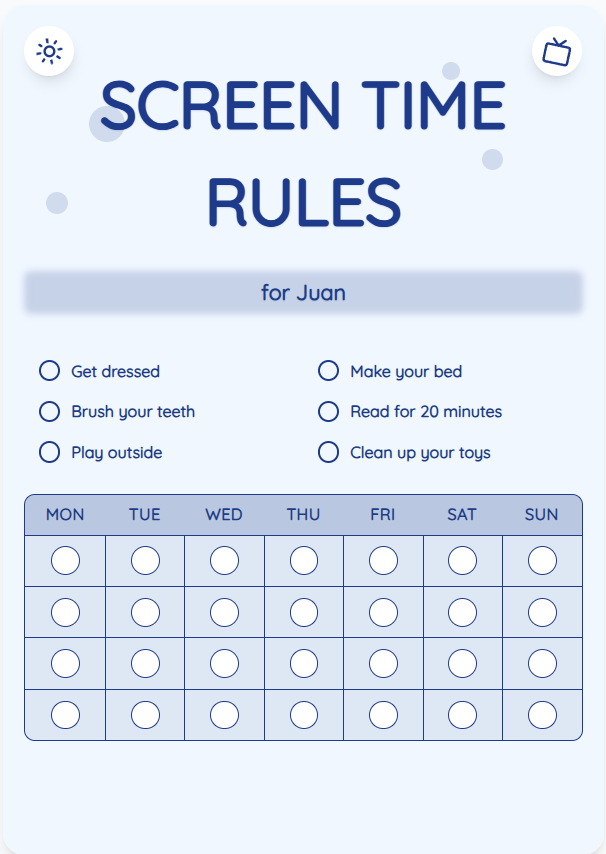Screen Time Limit Recommendations: A Guide for Parents of Children Ages 2-12
As a parent, managing your child's screen time can be challenging in today's digital age. Finding the right balance is crucial for their well-being and development. In this guide, we provide practical recommendations to help you set appropriate screen time limits for children aged 2-12.
See What Your Screen Time Chart Will Look Like
Here's an example of a beautiful, customizable screen time rules chart you can create for your family

Understanding Screen Time Guidelines
Before setting screen time limits, it's essential to understand the recommended guidelines. The American Academy of Pediatrics suggests limiting screen time to 1 hour per day for children aged 2-5, focusing on high-quality programming. For children aged 6 and older, consistent limits on screen time are advised, ensuring it doesn't interfere with sleep, physical activity, and other essential activities.
Creating a Screen Time Schedule
Establishing a screen time schedule can help regulate your child's device usage. Create designated time slots for screen time, such as after homework or chores are completed. Consider using a screen time chart generator like ScreenTimeRules.com to visualize and track your child's screen time allowance easily.
Put These Tips Into Action
Create a custom chart to implement these strategies with your child
Promoting Alternative Activities
Encourage your child to engage in non-screen activities like outdoor play, reading, arts and crafts, or family bonding time. Providing alternative options can reduce their dependence on screens and promote overall well-rounded development.
Setting Boundaries and Consistency
Consistency is key when it comes to enforcing screen time limits. Clearly communicate the rules to your child and establish consequences for exceeding them. Be a role model by practicing healthy screen habits yourself.
Practical Tips for Success
- Use a visual screen time chart to make limits clear and tangible for your child.
- Encourage open communication with your child about the importance of balanced screen time.
- Implement tech-free zones in your home, such as during meals and before bedtime.
- Engage in activities together as a family to reduce reliance on screens.
Frequently Asked Questions
How can I handle resistance from my child when enforcing screen time limits?
Address resistance by explaining the reasons behind the limits in a calm and understanding manner. Involve your child in setting the rules to give them a sense of ownership.
What are the signs that my child may be spending too much time on screens?
Signs include irritability when screen time is interrupted, neglecting other activities they used to enjoy, and experiencing physical symptoms like eye strain or headaches.
Is it okay to use screen time as a reward for good behavior?
While occasional use of screen time as a reward can be effective, it's essential to avoid using it as the primary incentive for behavior. Encouraging intrinsic motivation is more beneficial in the long run.
By implementing these screen time limit recommendations and strategies, you can support your child's healthy development and foster a harmonious family environment. Remember, moderation is key when it comes to screen time. Explore ScreenTimeRules.com for personalized screen time charts that simplify the process of managing your child's device usage.
Ready to Transform Your Family's Screen Time?
Join thousands of parents who have successfully managed screen time with our customizable charts.
